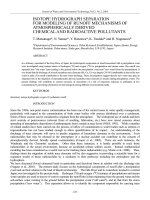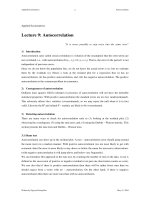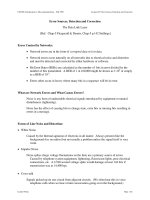Lecture 9 surface processes chemical and physical weathering and sedimentary rocks
Bạn đang xem bản rút gọn của tài liệu. Xem và tải ngay bản đầy đủ của tài liệu tại đây (6.29 MB, 45 trang )
Lecture 9: Surface Processes:
chemical and physical weathering and
sedimentary rocks
• Questions
– What is the rock cycle? How do rocks get destroyed
and recycled at the surface of the Earth?
– At the other end of the transport system, how do
weathered and eroded materials end up making the
various kinds of sedimentary rocks?
– What can observations of the sedimentary record reveal
about the tectonics, petrology, and climate of both
depositional environments and upstream source
environments?
• Reading
– Grotzinger and Jordan, Chapters 5, 16, 18, 19
1
Weathering and Sedimentation in the Rock Cycle
• Our geology so far has focused on internally-driven processes:
plate tectonics, magmatism, metamorphism, orogeny.
• The rest of geology is
driven by surface
processes: the
hydrologic cycle
(rainfall, streams,
ice), gravity, aqueous
chemistry.
• Weathering and erosion
are the processes that
form and transport form
sediment.
• Sedimentation, burial and
lithification are the
processes that transform
weathering products into
sedimentary rocks.
2
Weathering and Sedimentation in the Rock Cycle
• A more detailed view of the surface-driven parts of the rock cycle
shows the various steps between source rock and sedimentary
product
3
Weathering: decomposition of rocks
•
There is a distinction between
weathering and erosion:
– Weathering converts exposed
rock to soil in place
– Erosion transports dissolved
or fragmented material from
the source area where
weathering is occurring to a
depositional environment .
– Most of the earth’s surface is
covered by exposure of
sediment or sedimentary rock,
by area.
– But the sediment layer is thin
in most places, with respect to
overall crustal thickness, so
sedimentary rock is a minor
volume fraction of the crust
(in part by definition: once
buried to the mid-crust,
sediments get cooked to
metasediments).
4
Weathering: chemical and physical
•
The destruction of rocks at the Earth’s
surface by weathering has two
fundamental modes of operation:
– Chemical weathering is dissolution or
alteration of the original minerals,
usually by reactions with aqueous
solutions
• Chemical weathering puts ions from
the source minerals into solution for
subsequent erosion by transport in
flowing water as dissolved load.
– Physical weathering is fragmentation
into progressively smaller particles,
from intact outcrop to boulders and on
down to mineral fragments and sand
grains.
• Physical weathering makes loose pieces
of rock available for downslope
movement by mass wasting or
transport in flowing water as suspended
or bed load.
5
Chemical Weathering
•
Chemical weathering is driven by
thermodynamic energy minimization, just
like chemical reactions at high
temperature.
– The system seeks the most stable
assemblage of phases.
– The differences are that (1) kinetics are
slow and metastability is common; (2) the
stable minerals under wet, ambient
conditions are different from those at high
T and P; (3) solubility in water and its
dependence on water chemistry (notably
pH) are major determinants in the stability
of minerals in weathering.
•
•
A fresh rock made of olivine and
pyroxenes will end up as clays and iron
oxides, with other elements in solution
A fresh rock made of feldspars and quartz
will end up as clays, hydroxides, and
quartz in most waters.
6
Chemical Weathering
7
Chemical Weathering
•
The most common alteration product of feldspars is kaolinite, Al2Si2O5(OH)4,
which serves as a model for the formation of clays by weathering generally.
– The reactions of feldspars to kaolinite illustrate some of the basic trends:
•
•
•
•
K, Na, Ca are highly soluble and readily leached by chemical weathering.
Excess Si can be removed as silicic acid although quartz is relatively insoluble.
Al is extremely insoluble, and is essentially conserved as source rock is converted to clays.
Weathering is a hydration process, leaving H2O bound in the altered minerals.
– 2 KAlSi3O8 + 9 H2O + 2 H+ -> Al2Si2O5(OH)4 + 2 K+ + 4 H4SiO4
• Note the H+ on the left-hand side…only acidic water can drive this reaction
• Natural waters are acidic due to equilibrium of carbonic
acid with CO2 in the atmosphere
– CO2 (g) + H2O = H2CO3
– 2 KAlSi3O8 + 9 H2O + 2 H2CO3 ->
Al2Si2O5(OH)4 + 2 K+ + 4 H4SiO4 + 2HCO3–
– Alteration of rock transforms acidic rainwater into
neutral surface or ground water, with bicarbonate the
dominant species (relative to CO2 and CO32–).
– Mg and Fe2+ are also readily leached, but Fe3+ is very
insoluble…the ultimate residue of alteration of mafic
rocks is hematite.
8
Chemical Weathering
Knowing the chemistry of reaction of minerals to kaolinite, it is possible to
reconstruct from the dissolved ions in stream water the amount of each source
mineral that reacted with the water.
•
•
Questions: How do you do the correction for atmospheric input? Do the source
minerals in the Sierra Nevada all weather at equal rates?
9
Chemical Weathering
•
Some minerals are congruently soluble in acidic water, leaving no residue
– The most abundant is calcite: CaCO3 + H2CO3 = Ca2+ + 2HCO3– (the Tums reaction)
– Effects of dissolution (and precipitation) of calcite can be dramatic, to say the least.
Sinkhole
Karst terrain
Speleothems
10
Rates of Chemical
Weathering
Many factors affect the
rate at which a rock will
weather, as summarized
here.
• Some of these variables are
local (e.g., source rock),
some are global. These
include temperature and
pCO2, leading to the CO2weathering feedback cycle.
•
11
Physical Weathering
•
Anything that promotes disaggregration of a rock so that pieces can form soil or
be eroded away by wind, water, or gravity transport is physical weathering.
– The distinction between physical weathering and erosion is subtle, but think of physical
weathering as fragmenting the rock and erosion as carrying the fragments away; at
times these may be the same event, of course.
•
Rocks that are jointed or faulted or have pre-existing weak zones are most easily
weathered.
– Few of the stresses associated with physical weathering are significant compared to the
tensile strength of intact rocks; something, has to start the process, either initial cracks
and weaknesses or chemical attack on mineral cohesion.
•
•
•
•
•
Organisms, especially plants (think tree roots), are fond of breaking up rocks.
Freeze-thaw, frost wedging, frost heave…the volume change between ice and
water is effective in widening cracks in rock in suitable climates.
Physical abrasion by flowing air or water, or more often by rock particles already
mobilized by water or wind (think Fossil Falls).
Tectonics…rocks caught in a fault zone are definitely undergoing physical
weathering.
Etc.
12
Weathering feedbacks: chemical and physical
• Physical weathering and
chemical weathering
generally proceed in
parallel in most
environments.
• Physical and chemical
weathering promote one
another:
– Formation of cracks by
physical weathering
increases reactive surface
area, promoting chemical
weathering.
– Chemical weathering
replaces intact
interlocking minerals
with weak clays or void
space, making the rock
easier to physically
disaggregate, promoting
physical weathering
13
Weathering feedbacks:
more generally
• Weathering of both kinds plays
key roles in several feedbacks.
• Tectonics affects weathering
through slopes and elevations,
climate affects weathering
through temperatures (via
chemical kinetics and freezethaw), rainfall, pCO2, etc.
• Conversely, weathering and
erosion affect tectonics and
climate:
– Denudation by erosion must be
isostatically compensated and
so affect vertical motions of the
crust…
– Weathering controls water
chemistry, courses of streams
and groundwater, removes CO2
from the atmosphere, etc.
14
Soil formation
• Chemically and physically weathered rock that is not
eroded or transported but remains in place becomes soil.
• A weathered surface develops a
stratified structure, with intact rock
at the bottom (or inside) and
maximum weathering at the top .
• Leachable ions are transported
downwards by groundwater flow,
possibly redeposited as water
chemistry adjusts towards
equilibrium with the developing 15
soil profile.
Soil formation
• The mineralogy and thickness of soil layers depends on
source rock, climate (temperature and rainfall), and age.
• Which of these soil types would you rather farm?
16
Erosion and Transport
• Between weathering and sedimentation, matter must be
transported from source to destination. This is erosion.
– We dealt with the landforms generated by erosion in the
geomorphology lecture; here our concern is with the effects of
transport on sedimentary rocks.
• Modes of transport:
– Gravity (short distances and steep slopes)
– Wind (small particles only)
– Glaciers
– Water
• Surface runoff carries dissolved, suspended, and bed loads
• Groundwater flow only carries dissolved load
– All these mechanisms carry products of physical
weathering and insoluble residues of chemical
weathering.
– Only water transport carries away leached soluble
products of chemical weathering.
17
Erosion and Transport
• Certain modes of transport physically modify and
physically and chemically sort particles en route.
• Size sorting by surface water runoff flow:
Current of a given
velocity can generally
carry all noncohesive
particles smaller than a
critical size; since
current velocity drops
with decreasing slopes
from mountains to
lowlands, it follows that
sediments evolve from
poorly sorted and
coarse-grained near
source to well-sorted
and finer grained with
increasing transport
distance.
18
Erosion and Transport
• Chemical sorting with
increasing transport
distance is like a
continuation of
chemical weathering:
most stable minerals are
transported the farthest.
• Textures of particles are
modified by abrasion
during wind or water
transport. Close to
source particles are
angular; far from source
particles are rounded.
19
Sedimentation
•
•
Eventually transported particles and dissolved ions reach a place where they can
be permanently deposited and accumulated. This is sedimentation.
The sedimentary rocks that result from this accumulation are controlled by and
record the sedimentary environment where they were deposited.
– We interpret ancient sedimentary rocks by comparison to modern
environments where we can observe ongoing sedimentary processes and
relate them to the composition, texture, and structure of the resulting rocks.
20
Sedimentation
•
Sediments and the
environments in which they
form are fundamentally divided
into clastic and chemical:
– Clastic sediments are made of
physically transported and
deposited particles (they may
later gain chemically grown
cement during diagenesis)
– Chemical sediments are grown
from solution, organically or
inorganically; biochemical
sediment more specifically
refers to minerals grown from
solution by organisms
•
In some cases the relationship
between the environment and
the character of the sediment is
absolute and obvious
(carbonate in reefs, boulderstrewn till in periglacial
deposit, etc.); other cases are
more subtle.
21
Diagenesis
• The process of modification of
newly deposited sediments into
sedimentary rocks is diagenesis or
lithification.
– Processes include:
• physical compaction by the pressure of
overburden, accompanied by expulsion of
pore waters
• Growth of new diagenetic minerals and
continued growth of chemical sediments
from pore waters.
• Dissolution of soluble elements of clastic
rocks.
• Recrystallization and remineralization as
water chemistry, pressure, and
temperature evolve.
• At the high-T and P end, diagenesis
merges smoothly into the low-T and P
end of metamorphism. The distinction is
arbitrary.
22
Sedimentary Rocks
• The preserved end-result of weathering, erosion, transport,
sedimentation, and diagenesis is sedimentary rocks.
– Like sediments and sedimentary environments, the resulting rocks are
divided into clastic (or siliciclastic or volcaniclastic, etc.) and chemical (or
biochemical).
• Clastic rocks are classified by particle size (and sorting) and
composition.
23
Sedimentary Rocks
• Chemical sediments are primarily classified, of course, by
mineralogical composition.
24
Sedimentary rocks and environmental information
• How do sedimentary rocks preserve information about their
depositional environments?
– By composition, mineralogy and grain size, obviously, but also
through sedimentary structure
• Elements of sedimentary structure:
– Bedding
• Bed thickness, from finely laminated to massive
Burgess Shale:
fine
Vasquez formation: massive
30 m
30 cm
25









